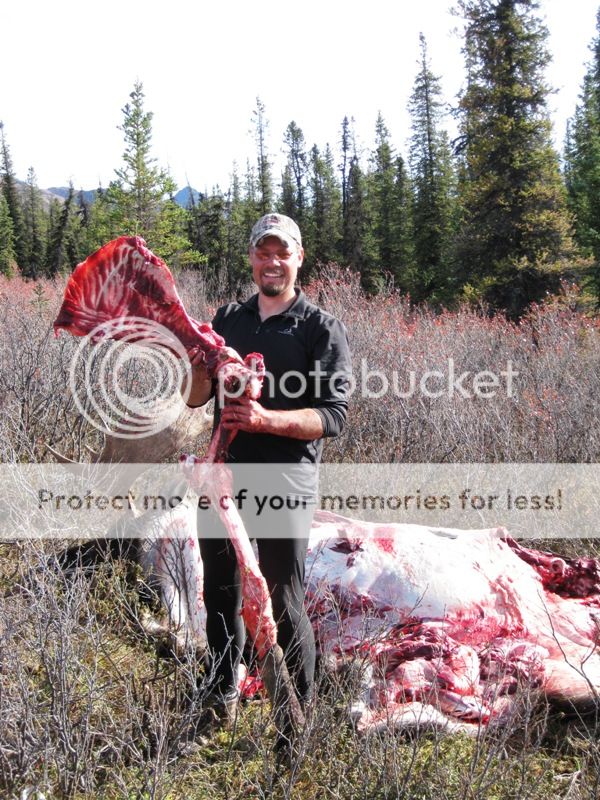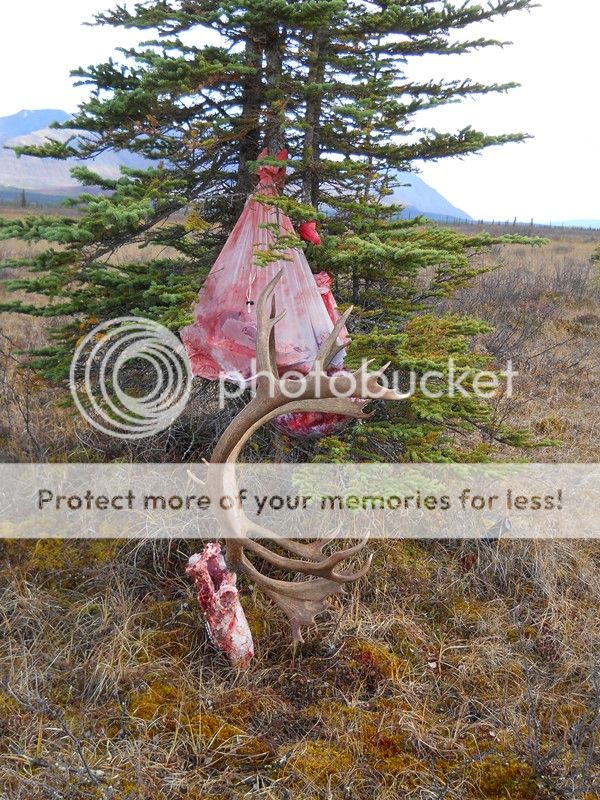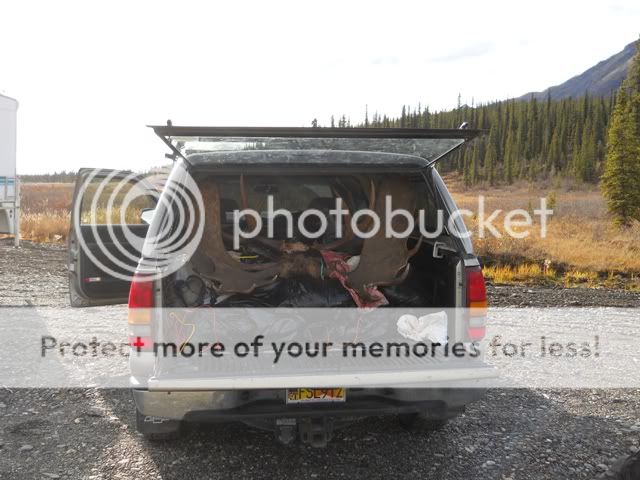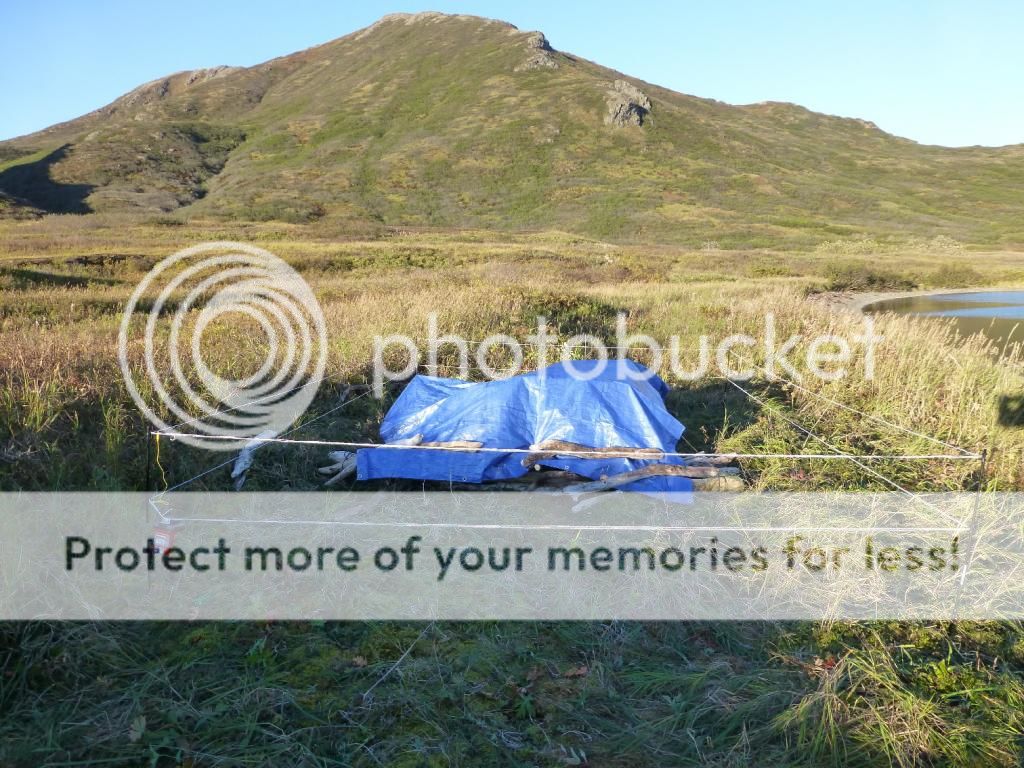Bambistew
Well-known member
One topic I rarely see is meat care in the field. The occasional topic usually includes going from point A (kill site) to point B (truck/home/butcher) ASAP. Put it in a cooler with ice, get it skinned, etc. That’s pretty easy stuff. What if point B is camp, for another week? I’m curious how you guys take care of meat in the field for extended periods of time. I’ve attempted to detail my method and reasoning’s below. By no means is this gospel, but it has worked for me with many, many animals. I’ve yet to have meat spoil even in temps approaching 80 deg in the day. I hope this helps newer guys who don’t have experience with meat care in the field and maybe even helps the guys who do. I think many of us deal with this issue so often we sometimes forget how much actually goes into meat care.

I know there are a lot of guys on here that have tons of experience with meat care, but there are also a lot of newer hunters, and guys that haven't really had to deal a big dead animal 5 miles from the truck... or farther for extended periods. I think the vast majority of hunters shoot an animal and have it hanging within 24hrs or less. I worked as a butcher for a while and got to see a pile of wasted meat. Some hunters couldn’t even make it from point A to point B without losing meat… in November. The usual loss was an elk (neck and shoulders), and the reason was not skinning the neck, or removing the windpipe. On a bull the hide is really thick on the neck, and traps heat, more so than the mane hair. Snow is also another spoiler… snow insulates and also traps heat. Get that animal in a position where the wind/air can circulate around it and it will cool out much better than in a snow bank.
A few things that I always have with me while in the field for game care, be it a day trip or a 10 day trip:
Game bags
Rope
Citric acid
Boning knife
Saw
Tarp.
Game bags - enough for animal, plus 1-2+ extra. This usually correlates to how many backpack trips it takes to get an animal from point A-B, or more simply one bag per trip. For instance a deer/sheep is usually 2, one for meat one for cape, an elk 3-4, and a moose is 6-7. I bring a couple extra so I can swap out meat into clean bags while I wash others;
Small diameter rope, at least 50', 100’ is better, this is for hanging bags, and tarp;
Citric acid powder (can be found in the bulk food section in most grocery stores). Mix 1oz per quart of water. This lowers the pH and reduces bacteria growth and repels insects. Spray (I bring a 6oz spray bottle at times) or sprinkle on liberally, re-apply every day or two. Apply liberally to areas where the muscle has been cut off the bone, i.e. around the ball joint on a hind quarter, or back straps.
Knife – I bring a commercial boning knife (Forchner 5"). I don’t have much use for a traditional hunting knife and haven’t packed one in years. Their shape and feel really don’t work that well for cutting up an animal. The way I look at it, if hunting knives were great for cutting meat, butchers would use them… Also with a small steal, I can sharpen the knife very easily and quickly, hunting knives are usually hard to sharpen in the field. The new Havalon style knives are pretty slick, but when I have a pile of meat to deal with I want a knife that I can make big fast cuts and while boning a critter, I apply a lot of pressure, twisting and turning. The Havalons don’t hold up too well that that style, but I can make due on smaller animals… still on the fence with them for anything outside of caping.
A game saw -This is of course personal preference, but I’ve been through a pile of saws from folding, to knap style, to Wyoming style. What I’ve found to be my favorite is a small 14” Stanley handsaw. It fits great in the pack right against my back, and works slick as hell for all sorts of tasks, such as cutting wood, or antler extraction. It weighs next to nothing and is the best I’ve found for my intended purpose. On extended hunts which include big animals I always take a saw. For a deer or sheep hunt I rarely take a one.
A small tarp – this is generally a 6x8 or 8x10 in size, made of the typical blue poly, a silnylon or a piece of visquene plastic. I prefer the blue tarp or silnylon as they usually have tie downs built in. They can be used to lay meat on during butchering (I usually use extra game bags for this) but its main purpose is to protect the meat from sun and rain once its bagged and waiting at Point B to go to Point C.
The four main reasons meat will spoil: heat, moisture, dirt and flies.
Bacterial grows in warm environments (heat), usually anything above 40 degrees, but the real caution number is 50. If you can keep meat around 40 degrees or less you can keep it for weeks. Moisture promotes the growth and spreads bacteria. Moisture can be found in the form blood, rain, or submerging in water, etc. Bacteria are everywhere, but higher concentrations are found in dirt, so keep the meat as clean as possible. Sticks, leaves, and plant matter is pretty much inert, and not something I worry about if it gets on the meat. Lastly, flies... flies and maggots thrive in warm, high bacterial environments and also spread bacteria from point to point.
Bacteria is your number one concern with meat care, if you can reduce the factors which promote growth you will increase your odds of keeping your meat longer. To do this you need to cool the meat, keep it clean, keep it dry and keep the bugs off it. Simple right?
Game bags are probably one of the most important pieces of game care and your first line of defense from bugs, and dirt. I prefer Tag Bags (or any synthetic) over cotton. These serve multiple purposes. First, they keep the meat clean and free of dirt/dust (obviously). The cheap cheese cloth bags are basically useless IMO. Dust/dirt can penetrate, flies can blow their eggs right through the mesh, or lay eggs on the mesh and the maggots burrow in.
Synthetic bags do not promote the growth of bacteria as readily as cotton because they don't retain moisture. Cotton will begin to grow mildew in about 24hrs if the temperature and humidity is high and the bags are damp, this in-turn promotes bacterial growth. Cotton absorbs moisture easily and is difficult to dry, be it water, or blood. If your meat is dripping blood, the cotton will absorb it, and will take forever to dry. I often wash game bags while in the field to rinse off blood and dirt. Cotton will not dry in lower temperatures, and takes forever even in warm temps. Synthetic bags will dry in about half an hour usually. Synthetic bags are generally stronger, lighter and less bulk than cotton as well. Lastly, synthetic bags will breathe better than cotton, mostly because the woven pores do not plug as easily due to the arrangement of the fibers in the fabric.
A bag that breathes is a big deal. A bloody bag will not breathe; they must be swapped out and/or rinsed/dried as needed to keep the blood from soaking the bags. You want your meat to be dry to the touch and form a crust which is another barrier to bacteria. A crust will form on the meat inside the bag if it’s in a well-ventilated area, or hung in such a way that air can readily circulate around it. The best way to crust the meat is to hang it directly in the wind without the bag (watch for bugs). If no bugs are present while I’m butchering, I will set the meat out on game bags, or rocks and let it cool and crust before bagging.
I try to keep meat in as big of chunks as possible, and make as few of cuts as I can. That means, that each quarter remains in one piece, with or without the bones. Take your time and be as clean and careful as possible to preserve meat in large chunks. I usually end up with about 12 pieces of meat, and no little scraps… quarters (4), loins/t-loins (4), rib/flank meat (2), and neck (1-2) pieces. The less surface area you have the less chance of bacterial contamination. Having the meat in big chunks makes applying citric acid much easier as well. I will liberally apply citric acid as the meat comes off the bone and is ready for the bag.

Ok, so we have all the meat off the animal, bagged and ready for stashing/cooling. I look for a tree that offers some shelter from the sun/rain and tie the bags up near the kill site and start packing one bag at a time back to camp. Once I get back to camp, I find a spot with good air flow (avoid depression/draw and thick brush/trees). I’ll tie up a meat pole and hang the bags, or tie to a tree with good branches that provide cover from the rain. With a meat pole I rope up a tarp to keep the bags dry and shaded. I will check the meat periodically, rotate the meat around in the bags to keep it from sticking and swap out bloody bags for fresh ones as needed. I will also re-apply citric acid daily. I’ve kept meat as long as 7 days in the field in temps between 35-60 deg, no problem… then took another 3-4 days to cut it up at home.

I hope this helps, and I’d love to hear other tips or tricks some of you may have.

I know there are a lot of guys on here that have tons of experience with meat care, but there are also a lot of newer hunters, and guys that haven't really had to deal a big dead animal 5 miles from the truck... or farther for extended periods. I think the vast majority of hunters shoot an animal and have it hanging within 24hrs or less. I worked as a butcher for a while and got to see a pile of wasted meat. Some hunters couldn’t even make it from point A to point B without losing meat… in November. The usual loss was an elk (neck and shoulders), and the reason was not skinning the neck, or removing the windpipe. On a bull the hide is really thick on the neck, and traps heat, more so than the mane hair. Snow is also another spoiler… snow insulates and also traps heat. Get that animal in a position where the wind/air can circulate around it and it will cool out much better than in a snow bank.
A few things that I always have with me while in the field for game care, be it a day trip or a 10 day trip:
Game bags
Rope
Citric acid
Boning knife
Saw
Tarp.
Game bags - enough for animal, plus 1-2+ extra. This usually correlates to how many backpack trips it takes to get an animal from point A-B, or more simply one bag per trip. For instance a deer/sheep is usually 2, one for meat one for cape, an elk 3-4, and a moose is 6-7. I bring a couple extra so I can swap out meat into clean bags while I wash others;
Small diameter rope, at least 50', 100’ is better, this is for hanging bags, and tarp;
Citric acid powder (can be found in the bulk food section in most grocery stores). Mix 1oz per quart of water. This lowers the pH and reduces bacteria growth and repels insects. Spray (I bring a 6oz spray bottle at times) or sprinkle on liberally, re-apply every day or two. Apply liberally to areas where the muscle has been cut off the bone, i.e. around the ball joint on a hind quarter, or back straps.
Knife – I bring a commercial boning knife (Forchner 5"). I don’t have much use for a traditional hunting knife and haven’t packed one in years. Their shape and feel really don’t work that well for cutting up an animal. The way I look at it, if hunting knives were great for cutting meat, butchers would use them… Also with a small steal, I can sharpen the knife very easily and quickly, hunting knives are usually hard to sharpen in the field. The new Havalon style knives are pretty slick, but when I have a pile of meat to deal with I want a knife that I can make big fast cuts and while boning a critter, I apply a lot of pressure, twisting and turning. The Havalons don’t hold up too well that that style, but I can make due on smaller animals… still on the fence with them for anything outside of caping.
A game saw -This is of course personal preference, but I’ve been through a pile of saws from folding, to knap style, to Wyoming style. What I’ve found to be my favorite is a small 14” Stanley handsaw. It fits great in the pack right against my back, and works slick as hell for all sorts of tasks, such as cutting wood, or antler extraction. It weighs next to nothing and is the best I’ve found for my intended purpose. On extended hunts which include big animals I always take a saw. For a deer or sheep hunt I rarely take a one.
A small tarp – this is generally a 6x8 or 8x10 in size, made of the typical blue poly, a silnylon or a piece of visquene plastic. I prefer the blue tarp or silnylon as they usually have tie downs built in. They can be used to lay meat on during butchering (I usually use extra game bags for this) but its main purpose is to protect the meat from sun and rain once its bagged and waiting at Point B to go to Point C.
The four main reasons meat will spoil: heat, moisture, dirt and flies.
Bacterial grows in warm environments (heat), usually anything above 40 degrees, but the real caution number is 50. If you can keep meat around 40 degrees or less you can keep it for weeks. Moisture promotes the growth and spreads bacteria. Moisture can be found in the form blood, rain, or submerging in water, etc. Bacteria are everywhere, but higher concentrations are found in dirt, so keep the meat as clean as possible. Sticks, leaves, and plant matter is pretty much inert, and not something I worry about if it gets on the meat. Lastly, flies... flies and maggots thrive in warm, high bacterial environments and also spread bacteria from point to point.
Bacteria is your number one concern with meat care, if you can reduce the factors which promote growth you will increase your odds of keeping your meat longer. To do this you need to cool the meat, keep it clean, keep it dry and keep the bugs off it. Simple right?
Game bags are probably one of the most important pieces of game care and your first line of defense from bugs, and dirt. I prefer Tag Bags (or any synthetic) over cotton. These serve multiple purposes. First, they keep the meat clean and free of dirt/dust (obviously). The cheap cheese cloth bags are basically useless IMO. Dust/dirt can penetrate, flies can blow their eggs right through the mesh, or lay eggs on the mesh and the maggots burrow in.
Synthetic bags do not promote the growth of bacteria as readily as cotton because they don't retain moisture. Cotton will begin to grow mildew in about 24hrs if the temperature and humidity is high and the bags are damp, this in-turn promotes bacterial growth. Cotton absorbs moisture easily and is difficult to dry, be it water, or blood. If your meat is dripping blood, the cotton will absorb it, and will take forever to dry. I often wash game bags while in the field to rinse off blood and dirt. Cotton will not dry in lower temperatures, and takes forever even in warm temps. Synthetic bags will dry in about half an hour usually. Synthetic bags are generally stronger, lighter and less bulk than cotton as well. Lastly, synthetic bags will breathe better than cotton, mostly because the woven pores do not plug as easily due to the arrangement of the fibers in the fabric.
A bag that breathes is a big deal. A bloody bag will not breathe; they must be swapped out and/or rinsed/dried as needed to keep the blood from soaking the bags. You want your meat to be dry to the touch and form a crust which is another barrier to bacteria. A crust will form on the meat inside the bag if it’s in a well-ventilated area, or hung in such a way that air can readily circulate around it. The best way to crust the meat is to hang it directly in the wind without the bag (watch for bugs). If no bugs are present while I’m butchering, I will set the meat out on game bags, or rocks and let it cool and crust before bagging.
I try to keep meat in as big of chunks as possible, and make as few of cuts as I can. That means, that each quarter remains in one piece, with or without the bones. Take your time and be as clean and careful as possible to preserve meat in large chunks. I usually end up with about 12 pieces of meat, and no little scraps… quarters (4), loins/t-loins (4), rib/flank meat (2), and neck (1-2) pieces. The less surface area you have the less chance of bacterial contamination. Having the meat in big chunks makes applying citric acid much easier as well. I will liberally apply citric acid as the meat comes off the bone and is ready for the bag.

Ok, so we have all the meat off the animal, bagged and ready for stashing/cooling. I look for a tree that offers some shelter from the sun/rain and tie the bags up near the kill site and start packing one bag at a time back to camp. Once I get back to camp, I find a spot with good air flow (avoid depression/draw and thick brush/trees). I’ll tie up a meat pole and hang the bags, or tie to a tree with good branches that provide cover from the rain. With a meat pole I rope up a tarp to keep the bags dry and shaded. I will check the meat periodically, rotate the meat around in the bags to keep it from sticking and swap out bloody bags for fresh ones as needed. I will also re-apply citric acid daily. I’ve kept meat as long as 7 days in the field in temps between 35-60 deg, no problem… then took another 3-4 days to cut it up at home.

I hope this helps, and I’d love to hear other tips or tricks some of you may have.





